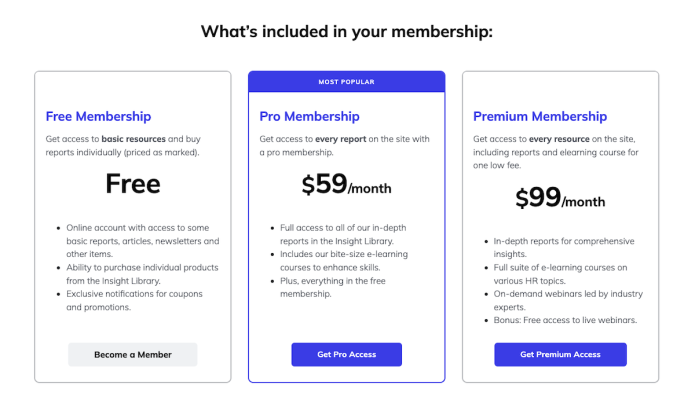
Setting up your membership business model and a website that showcases your content and takes payments is a great first step in getting your membership community up and running.
Once you have members who have signed up for your content, you should also consider the idea of fostering group communication within your membership.
Even if you have a membership model that is predicated on certain groups that you specifically don’t want to be engaging with each other (for example, students vs. instructors or members vs. facilitators), it’s still a great idea to promote each community on its own.
There are many popular tools out there for communication - that’s what the internet is all about, right? So we’ve narrowed it down to the top 5 apps for community engagement that are often used by membership managers.
1. Facebook Group
This form of engagement is extremely popular, and you will find most course creators and membership website administrators have some sort of Facebook group available for their members to access for free.
Advantages
The advantage to this is that everyone (literally) has a Facebook account, and can easily click a link to add themselves to the group. Admins can also decide whether to allow the access or not, and can ask questions as a sort of pre-screening mechanism. Presumably, if a member has paid to be in your community, you don’t want to throw up barriers to allowing them into the Facebook group, so most admins allow the member to join immediately on clicking the link.
Admins also have some neat features at their disposal with Facebook groups, including the ability to run polls, create live videos, and of course, engage in real time. The other advantage is that setting up a Facebook group is free.
Disadvantages
As you have probably heard before, your data is not your own on Facebook, and that can potentially be a major problem. If for some reason, your group is taken down, you will have lost all the conversations and member information. You cannot download all the data from your group into a database, either. Another disadvantage is that your members have to go back and forth between your website and the Facebook page to truly be an engaged participant. Sharing comments is a wonderful way to keep members talking to each other, but remember, your overall goal is to keep members on your website, not going off to Facebook, where there are always a multitude of other distractions available.
2. WhatsApp
Let’s face it, everyone is turning to their mobile phone for communication by text these days. What’s App can be an effective way to give your members a community forum that is easy to access and can be configured for desktop access if desired. Initially released in 2010 as a text messaging app, WhatsApp was acquired by Facebook in 2014. Today, the app has more than 1 billion users, making it the most popular messaging app in the world.
Advantages
Set-up is fairly simple, just download the app and start inviting people to your group. You can sub-divide your group into topics or by member group. An additional advantage is What’s App’s end-to-end encryption, which means private conversations are guaranteed to be just that. Your messages are not available to be intercepted by anyone, not even What’s App.
Disadvantages
Again, this app, while handy, takes your members away from your website, and requires a bit of back and forth for members. And with all the notifications about various updates that everyone sees on their phone these days, notifications for your group can be lost or not acted on right away, leaving members to remember to check their What’s App for messages.
3. Slack
Most often used for teams and co-worker communication, Slack can also be used as a member group communication system. Once it is set up, you can create different workspaces, and different channels within each workspace. Let’s say you have a membership business for fitness and nutrition clients, and another one related to your passion for golf. You would create a workspace for each business, and then the appropriate channels within each.
Advantages
Channels are very versatile in Slack. Admin has control over how many are created, whether they are private or for all participants, and who you want to be invited to each group. Channels can be arranged by topic, category, member group, or all of those and more. The idea is to allow a controlled space for you and members to engage.
Again, this can take a bit of setup to get going, but once you have it running, it’s an easy platform to use. Members can be advised by notification when a new comment is made, and the name of the channel is bolded when there are messages to pick up.
Disadvantages
One downside of Slack is that when replying to a comment, the channel name does not turn to bold text. Members still get the notification, but it might not be immediately apparent where they should go to pick up the message. If you have a large group, it could become confusing when comments are constantly being replied to.
Unlike Facebook, not everyone has a Slack account, and isn't the most straight forward to create. Most people think of Slack as a business app rather than a community forum, so members may be a little reluctant to jump in.
4. Discourse
Discourse has been around for many years and has always been a popular community communication option. You can use it as a mobile app or an online forum on desktop.
Advantages
A unique advantage to Discourse is that it’s “open source”. What that means is that you own the data. Unlike Facebook and Slack, your conversations are your own property and can never be lost. In fact, you can download your data to a database if you wish.
Discussions can be public or private, and you can create topics and subtopics to help users find the conversations they are interested in. Discourse also offers a 14-day free trial.
Disadvantages
The Basic service is limited to private discussions only, and all participants must be invited. If you want to be able to offer public discussions and allow members to join freely, the Standard tier is $100/month.
5. On-Site Forum
A distinct disadvantage of all the above-mentioned off-site options is that none of them can be embedded into a website. Which means your best option may be to take advantage of built-in forums within the membership platform you are using.
Advantages of an on-site forum for member communication
If you're using WordPress, there are a number of plugins that are available. If using a dedicated membership platform, some offer a built-in forum and some don’t.
The SubHub platform’s member forum offers the ability to create unlimited forums, topics, and discussions. Members can be notified by email when there are replies to comments. Avatars are picked up from member profiles, which all members have access to. By default, the forum is member-only access. The public view shows just enough to encourage those interested in the topics to join as a member. In addition, forums can be restricted by member group.
Disadvantages of an on-site forum
Built-in forums often don’t allow members to upload images and videos, but can provide links. An image link can be created by uploading an image via a media manager, and linking to the resulting URL. Videos hosted on YouTube, Vimeo.com or another third-party hosting service can be easily linked. Many membership managers actually prefer to not have the distractions of images and videos in member discussions, as it can leads discussions off into unrelated tangents. Most admins prefer to keep the discussion to the material they are providing.
Final Note
By far the number one reason to use a built-in forum right on your membership website is the ease of use for your members. They can simply click on the link to reach the forum anytime they are on your site. This of course, keeps your members engaged where you want them to be - on your website.
Haven't started your membership website yet? Get started with a free 14-day trial:




